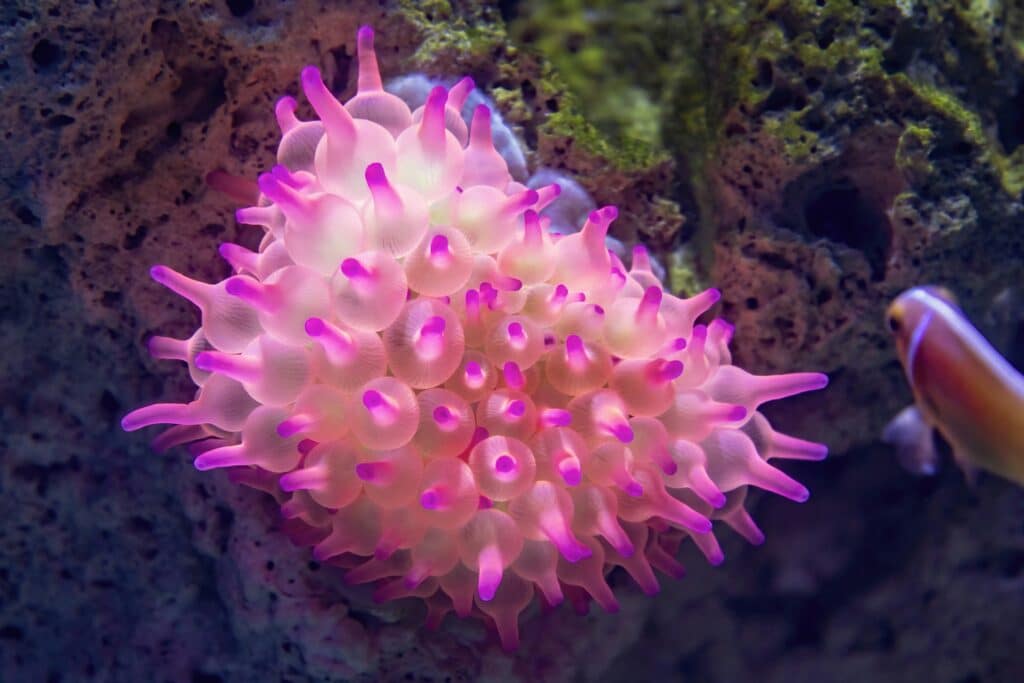What are Cnidarians? Everything You Need to Know
There’s an endless number of fascinating creatures that call our world’s oceans home, with so many still left to discover and learn more about. Some of the most interesting are invertebrates, which refer to any species without a backbone. Invertebrates come in many different forms, shapes and colours, and in this post, we’ll be diving into a certain type of invertebrate in even more detail – the cnidarians.
What is a cnidaria?
You’ve no doubt already heard of many of the animals that belong to the phylum of Cnidaria. A phylum is much bigger than a family and can include a great number of different species under one umbrella term.
Pronounced ‘nih dare ee uh’, the phylum Cnidaria is actually home to around 10,000 different species. These are split into many classes such as, Anthozoa, Scyphozoa, Cubozoa and Hydrozoa which we’ll explain in more detail later.
The name for this group of animals comes from the Greek ‘cnidos’ which means stinging nettle, which might give you a clue to the species that we’re talking about!
What animals are classed as cnidarians?
So, just which animals are we learning about here? As we mentioned, the cnidarians are split into four further groups based on their features and characteristics.
- Anthozoa: This particular group includes corals and sea anemones. They are sessile, which means they typically don’t move. An example is the bubble tip anemone (Entacmaea quadricolor) which you can see right here at Blue Planet Aquarium in our Coral Cave exhibit.
- Scyphozoa: This class of animal includes the true jellyfish, known for their bell-shaped bodies and trailing tentacles. They are free swimming and are found around the world. Some examples include the moon jellyfish and lion’s mane jellyfish.
- Cubozoa: This group includes the box jellyfish, which are differing in shape to the above. They are particularly known for their venom and are highly advanced creatures.
- Hydrozoa: This class includes a diverse variety of potentially lesser known species, including hydroids. Some of the most interesting include the Portuguese man o’ war, which is an animal made up of a colony of organisms working together and is venomous.

What are the characteristics of cnidarians?
While this phylum has a huge number of different species within it, cnidarians do have some shared characteristics. Firstly, cnidarians have one of two basic body forms: medusa and polyp. Medusae are typically free flowing and will move around, like jellyfish, while polyps are usually sessile and fixed in one place, like anemone. A polyp is a tube-shaped body that is hollow, with a mouth at one end and tentacles around it.
Cnidarian bodies are radially symmetric, which means their body parts are arranged around a central point. They typically lack organs like the brain, and instead have what’s known as a decentralised nervous system. This means it is distributed across the body instead of centred in the brain like humans.
As we mentioned earlier, the word ‘cnidos’ means stinging nettle. With that in mind, cnidarians all have stinging cells containing nematocysts or cnidocysts. They are usually located in the tentacles or outer areas of the species, and are used both for defence and for catching prey. These cells inject venom and immobilise their prey.
In many cases, cnidarians display mutual relationships with other species in order to survive. For example, the most well-known example is the symbiotic relationship between coral and an algae known as zooxanthellae. Most reef-building corals contain these algae, with the coral providing a protected environment for the algae, while the zooxanthellae use photosynthesis to help the coral remove waste and access essential nutrients. With global climate change, more and more coral are going through a process known as coral bleaching, this is when corals are too stressed and expel the algae from their bodies and as such lose a large proportion of their energy income.

Where do cnidarians live?
Cnidarians are found in almost all ocean habitats, including shallow coastal waters to the deep sea. They are even found in cold waters, although some species prefer warmer climates.
Reef-building corals need shallower water that allows light for photosynthesis. Most reefs are found between the Tropics of Cancer and Capricorn. Overall, coral needs saltwater to survive and so they are only found in the ocean. For example, the bubble tip anemone is usually found in the tropical waters of the Indo-Pacific, including the Red Sea.
Jellyfish live in the world’s oceans, from deep to shallow water including coastlines. They are usually found in both tropical and arctic waters. You can even spot some species of jellyfish right here in the UK. The barrel jellyfish is the one of the largest in the UK seas, with a mushroom-shaped body and 8 frilly tentacles. They swim in warmer coastal waters and can be seen washed up on beaches in the early summer.

What do cnidarians eat?
Cnidarians can capture their next meal through a number of different methods, including their stinging cells and the symbiotic relationship with algae. In some cases, cnidarians can directly absorb any dissolved organisms in the water too.
They are carnivorous and will eat a variety of food, as it can typically depend on their size. Most cnidarians will eat plankton and small fish, while some species will also eat crustaceans. Some jellyfish even eat other jellyfish!
Most cnidarians will guide their food into their mouth after stinging it. They usually wait for prey to pass by, rather than actively hunting it. Interestingly, cnidarians have no separate organ to remove waste, and will use their mouth for this purpose after feeding.
So, there you have it! You have no doubt already heard of many different types of cnidarians, but you may not have known they were all part of the same fascinating group of animals. Don’t forget to book your tickets to Blue Planet Aquarium today where you can learn many more facts about our aquatic creatures!


